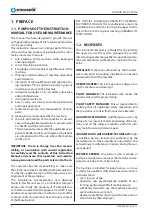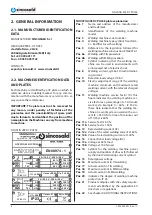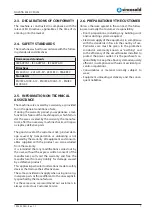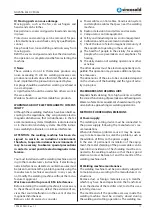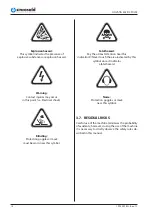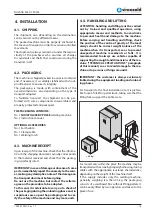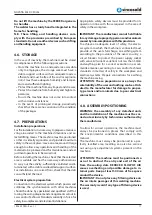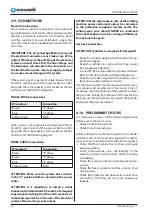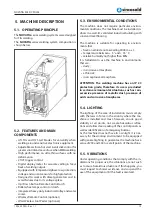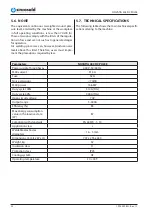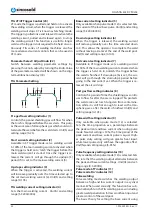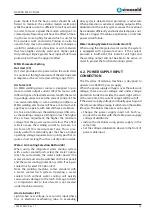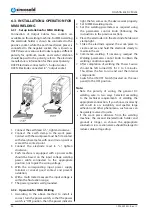
DIN 11 protection grade.
- Protect people near the welding area.
- REMEMBER: The arc can blind or damage your
eyes. The arc is dangerous up to a distance of 15
metres. Never look at the arc with the naked eye!
- Prepare the welding area so as to reduce reflection
and transmission of ultraviolet radiation: paint
walls and exposed surfaces black to reduce reflec-
tion, installing protective screens or curtains, to
reduce ultraviolet transmissions.
- Replace the mask lenses when they are damaged
or broken.
C) Welding wire
Attention: the welding wire can cause perforated
wounds.
- Do not press the button on the welding torch be-
fore carefully reading the instructions for use.
- Do not point the torch towards parts of the body,
other people or metals, when mounting the weld-
ing wire on the welding machine.
D) Explosions
- Do not weld above or near pressurised containers.
- Do not weld in an atmosphere containing explo-
sive powders, gases or vapours.
This welder uses inert gases such as CO2, ARGON, or
ARGON + CO2 mixtures to protect the arc, therefore it
is necessary to pay the utmost attention to:
1) Cylinders:
- Handle or use pressurised cylinders in accordance
with the regulations in force.
- Do not connect the cylinder directly to the machine's
gas pipe, without using a pressure regulator.
- Do not use cylinders that leak or are physically
damaged.
- Do not use cylinders that are not well secured to
the welding machine or to suitable supports.
- Do not transport cylinders without the valve pro-
tection fitted.
- Do not use cylinders whose contents have not
been clearly identified.
- Do not put the cylinder in electrical contact with
the arc.
- Do not expose cylinders to excessive heat, sparks,
molten slag or flames.
- Do not tamper with the cylinder valves.
- Do not attempt to unlock blocked valves with
hammers, keys, tools or other systems.
- Never delete or alter the name, number or other
markings on the cylinders. It is illegal and dangerous.
direct superior of any defects or anomalies presented
on the mobile parts.
A) Electric shock
ELECTRIC SHOCK CAN BE FATAL!!!
- All electric shocks are potentially fatal.
- Do not touch live parts.
- Insulate yourself from the piece to be welded and
from the earth, wearing insulating gloves and
clothes.
- Keep clothing (gloves, shoes, headgear, clothes)
and body dry.
- Do not work in damp or wet environments. Do not
lean on the piece to be welded.
- If you have to work near or in an area at risk, use all
possible precautions.
- If you also feel a little electric shock, stop welding
immediately; do not use the device until the prob-
lem is identified and resolved.
- Provide an automatic wall switch, of adequate ca-
pacity and possibly in the vicinity of the machine,
to immediately cut off the device in the event of
an emergency situation.
- Frequently inspect the power cord.
- Disconnect the power cord from the mains before
working on the cables or before opening the ma-
chine.
- Do not use the machine without the protective
bulkheads.
- Always replace any damaged parts of the machine
with original materials.
- Never bypass machine safety devices.
- Make sure that the power supply line is equipped
with an efficient earth socket.
- Make sure that the work bench and the work piece
are connected to an efficient earth socket.
- Never electrically and simultaneously touch "hot"
parts of pliers connected to two welders because
the voltage between the two can be the total of
the no-load voltage of both welding machines.
- Any maintenance must be performed only by
expert personnel, aware of the risks due to the
voltages necessary for the operation of the equip-
ment.
B) Radiation
Ultraviolet radiation, emitted from the electric arc,
can damage the eyes and burn the skin.
Follow the instructions below:
- Wear appropriate clothing and protective masks.
- DO NOT use CONTACT LENSES!!! The intense heat
emanating from the electric arc could stick them
to the cornea.
- Use masks with lenses, with a minimum DIN 10 or
9
1.995.229 EN - Rev. 1.1
NOVATIG 403 DC PULSE




